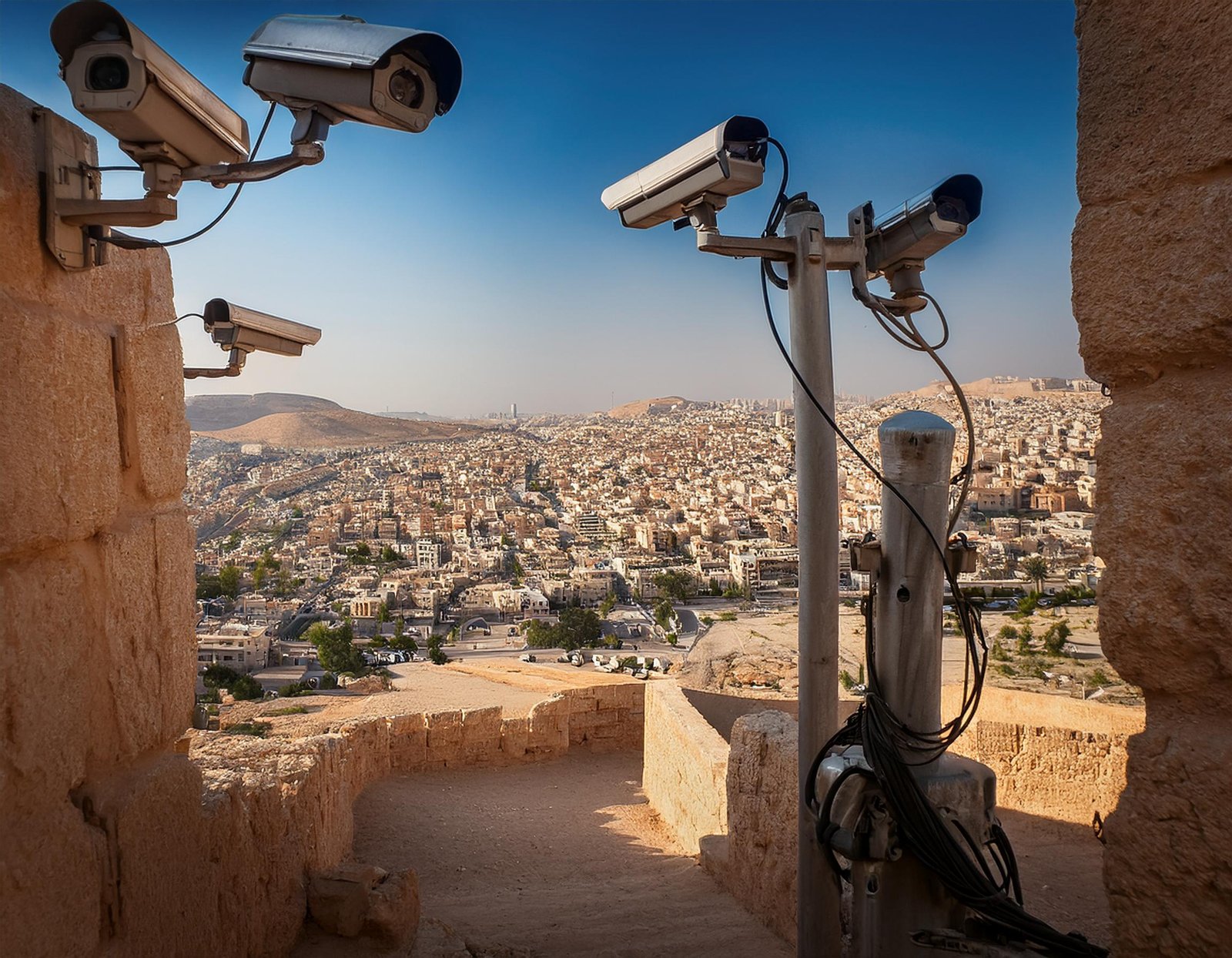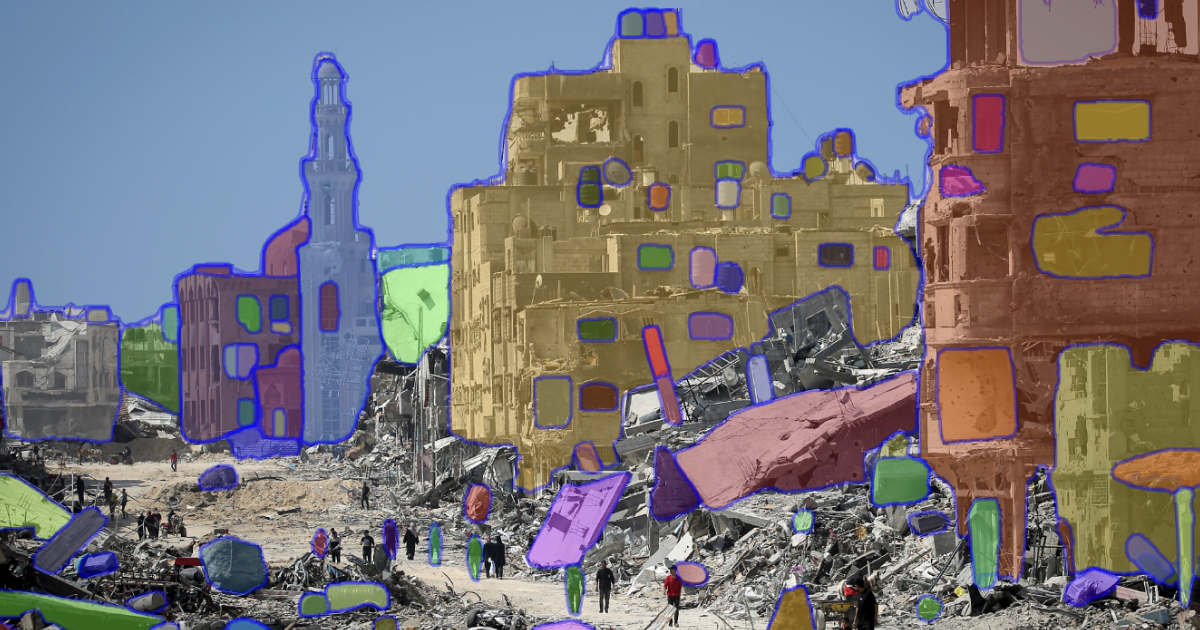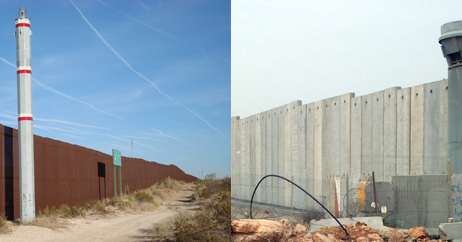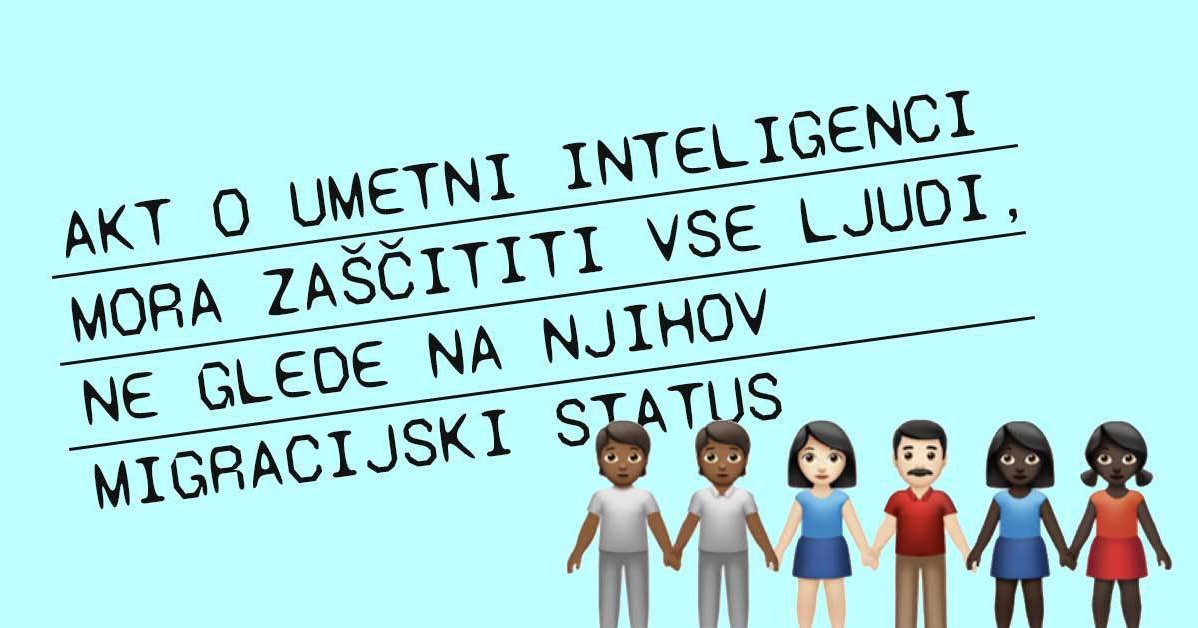Morilska umetna inteligenca ali morilske države? Uporaba umetne inteligence za nadzor in genocid v Palestini ter širši globalni kontekst.
23. avgust 2024
Besedilo temelji na razpravi s panela, ki smo ga organizirali v sklopu festivala Grounded v Ljubljani avgusta 2024. Govorkam in govorcem se zahvaljujemo za njihove prispevke k pogovoru ter pomoč pri pripravi povzetka. Zaradi zaščite zasebnosti smo se odločili, da njihovih imen ne objavimo.

Palestinsko mesto pod nadzorom izraelskih kamer. Generirano z Adobe Firefly.
Izrael nad Palestinci že desetletja izvaja invaziven nadzor, s katerim krši njihove temeljne pravice. Žal se z napredkom na področju umetne inteligence (UI), ki je posledica zmogljivejših računalnikov, oblačnih storitev in ogromnih količin podatkov, razvijajo tudi represivne tehnologije. To se jasno kaže v izraelskih napadih na Palestino tako v Gazi kot na Zahodnem bregu.
Izrael v podporo apartheidu ter za nadziranje prebivalcev in izvajanje pobojev uporablja mnogo različnih, z umetno inteligenco povezanih orodij. Tako so v preteklosti zlasti na Zahodnem bregu za nadzor meja že uporabljali avtonomne drone in avtomatizirano strojno orožje ter obsežne biometrične sisteme, ki temeljijo na UI. Tehnološka, vojaška in gospodarska premoč Izraela resno ogrožajo človekove pravice Palestincev, saj določajo načine, na katere umetnointeligenčne tehnologije posegajo v njihovo vsakdanje življenje.
Gibanje po Zahodnem bregu je za Palestince podobno premikanju po odprtem panoptikonu. Podvrženi so sistemu dovolilnic, s katerim upravlja izraelski okupator, ki za to med drugim uporablja aplikacijo Al-Munasiq. Tovrstne aplikacije zbirajo informacije o Palestincih – tako tiste, ki so neposredno povezane z dovolilnicami, kot tudi podrobnejše – in jih delijo z izraelskimi varnostnimi službami. Obenem Izrael upravlja še register prebivalstva ter Palestincem na zasedenih ozemljih na Zahodnem bregu, v Gazi in Vzhodnem Jeruzalemu izdaja osebne izkaznice, ki določajo stopnjo njihove svobode.
Palestinci morajo za premike med mesti dnevno prečkati izraelske nadzorne točke. Te točke so nekoč delovale bolj “analogno”, zdaj pa postajajo vse bolj odvisne od raznovrstnih tehnologij. Vojaki IDF fotografirajo prevozna sredstva, registrske tablice in obraze ter od Palestincev terjajo odgovore na različna vprašanja. Z aplikacijo Blue Wolf – izraelskim sistemom za prepoznavanje obrazov – zbirajo osebne podatke, kot so kraj rojstva, informacije o družinskih članih in morebitnem interesu izraelskih oblasti za njihovo zaslišanje, ter jih vnašajo v obsežno podatkovno bazo Wolf Pack. Blue Wolf se tako uporablja tudi za takojšen pregled vseh shranjenih informacij. Da bi vojake spodbudili k pridobivanju čim večje količine podatkov o čim več Palestincih, je aplikacija celo igrificirana – tisti, ki zberejo največ podatkov, lahko na primer dobijo več prostih ur in druge službene ugodnosti.

Izraelska nadzorna točka Temple Mount. Wikipedia Commons.
Na nadzornih točkah v mestih na Zahodnem bregu, kot je Hebron, ki je bil v sklopu projekta pametnega mesta opremljen s 360-stopinjskimi umetnointeligenčnimi kamerami in točkami z orožjem na osnovi UI, ter v Vzhodnem Jeruzalemu pa je zbiranje podatkov bolj avtomatizirano. Sistem z imenom Red Wolf s kamerami visoke ločljivosti skenira Palestince brez njihove privolitve in jih, preden jim dovoli prehod, primerja z biometričnimi vnosi v bazi Wolf Pack. Če posameznik še nima vnosa, bo prehod zavrnjen. Prav tako lahko Red Wolf zavrne prehod na podlagi drugih informacij, na primer, če oblasti osebo iščejo za zaslišanje ali aretacijo. Občutek nenehnega opazovanja je tako vse preveč resničen. Čeprav nas skušajo vlade po vsem svetu prepričati, da se nimamo česa bati, če ničesar ne skrivamo, da torej umetnointeligenčne tehnologije za nadzor in vojskovanje na nas nimajo vpliva, bi nas morale vsakodnevne izkušnje Palestincev prepričati o nasprotnem.
Če pred trenutnim napadom Gaza še ni bila podvržena tako obsežnemu tehnološkemu nadzoru, pa je Izrael situacijo izkoristil za zbiranje novih podatkov, s katerimi napaja svoje sisteme UI, ki temeljijo na napovedni analitiki. Trenutno poznamo tri zloglasne sisteme: The Gospel, ki išče infrastrukturne cilje, Lavender, ki išče človeške cilje, ter Where's Daddy?, ki slednje identificira na njihovih domovih in jih označi za napad. Način delovanja teh orodij veliko razkrije tudi o delovanju Izraela: Lavender na primer uporablja podatke, zbrane z obsežnim sistemom množičnega nadzora (torej z uporabo uličnih kamer, biometričnih nadzornih točk, podatkovnih baz in celo aplikacije Google Photos za prepoznavanje obrazov). Orodje zbrane informacije analizira glede na določene značilnosti in prebivalcem Gaze dodeli oceno od 1 do 100. Življenje ali smrt sta lahko odvisna od dejavnikov, kot so spol, naslov, starost, družina in članstvo v WhatsApp skupinah.

Uničenje v Gazi kot ga vidi algoritem računalniškega vida. Danes je nov dan.
Z razvojem, preizkušanjem in prodajo tehnološko podprte vojaške opreme je Izrael politične probleme, ki mu niso bili v ponos – kolonializem, okupacijo, represijo drugih narodov –, spremenil v tržno privlačen model nadzora nad prebivalstvom in zagotavljanja notranje varnosti. Zdaj se lahko promovira kot zagonska država, ki proizvaja orodja za urbano vojskovanje, primerna za vedno bolj razširjeni področji protiterorizma in varnostnih ukrepov. Mnoge vlade so to idejo pripravljene sprejeti in uporabljati izraelsko tehnologijo, ki jo ta predstavlja kot “preizkušeno v boju”. Izrael je tako izkoristil tržno priložnost, vendar pa je njegov uspeh pri izvozu neločljivo povezan z vojaško, gospodarsko in politično podporo ZDA.
Čeprav je brutalnost, s katero Izrael uporablja tovrstne tehnologije, za nas šokantna, pa je za mnoge države privlačna. Namen izraelskega vojaško-industrijskega kompleksa, ki ga sestavljajo tako državna kot zasebna podjetja, ni zgolj brezsmiselno ubijanje, temveč tudi uporaba okupirane Palestine kot testnega okolja za orožja in orodja nadzora, namenjena za prodajo na svetovnem trgu (tako avtoritarnim in demokratičnim državam).
Tehnologije, uporabljene za nadzor in vojskovanje, so namenjene zmanjševanju osebnega stika izraelskih vojakov s palestinskim prebivalstvom – ne da bi povzročile manjšo škodo, temveč za zaščito vojakov pred palestinskim odporom in varovanje ugleda izraelske okupacije pod pretvezo objektivnosti. Prav tako UI pospešuje hitrost vojskovanja z vidika števila tarč in časa, ki je na voljo za odločanje o njih. Medtem ko ti sistemi zmanjšujejo sposobnost ljudi za nadziranje ustreznosti računalniško generiranih ciljev, pa zaradi vrednosti, ki jo ponavadi pripisujemo računalniškim sistemom, obenem ustvarjajo videz objektivnosti in statistične pravilnosti sprejetih odločitev. V primeru Izraela so očitna zavajanja podjetij in vlad, ki se z razglašanjem, da bo UI rešila nekatere najbolj zapletene družbene, gospodarske in politične probleme, poskušajo znebiti odgovornosti za grozljive posledice uporabe teh tehnologij.
Uporaba orožja, ki ga poganja UI, ima resen potencial za kršenje človekovih pravic, opredeljenih v Mednarodnem paktu o državljanskih in političnih pravicah. Nediskriminatorni napadi, ki smo jim priča v Gazi ter so bili izvedeni z uporabo orodij Gospel, Lavender in Where’s Daddy?, kažejo na kršenje številnih pravic, skupaj z drugimi dejavniki, kot so genocidna retorika, prisilno stradanje in popolno obleganje Gaze, pa nakazujejo na možnost kaznivega dejanja genocida.
Uporaba orodij za vojskovanje, podprtih z UI, ali nadzornih točk z umetnointeligenčnimi sistemi in avtonomnim orožjem, ki lahko sledijo ljudem ter izstreljujejo solzivec, šok granate in gumijaste naboje, ustvarja nevaren precedens glede posledic teh tehnologij za civilno prebivalstvo. Zato je nujno, da mednarodna skupnost ukrepa ter zaščiti človekove pravice in druga pravila mednarodnega prava, namenjena varstvu civilistov. Postavljanje človeka v središče vsake odločitve o končanju človeškega življenja je eden redkih novih mednarodnih standardov na področju uporabe UI v konfliktih – odločitev o tem, ali bo človek ubit, ne sme biti prepuščena strojem ali algoritmom. Vendar pa izraelska uporaba UI v Gazi to normo spodkopava, še preden se je lahko popolnoma uveljavila. Če mednarodna skupnost ne bo ukrepala, bo postopna normalizacija takšnih praks – kot se je v preteklosti že zgodilo npr. z uporabo satelitske tehnologije za vojaške namene v zalivskih vojnah – vplivala tudi na orožja, podprta z UI.
Kljub vsemu pa ne smemo prezreti širšega konteksta. Dejanja Izraela niso posledica tehnologije, temveč uporabe tehnologije s strani države, ki že desetletja dehumanizira Palestince. Umetna inteligenca je le najnovejše v vrsti sredstev, ki služijo istemu genocidnemu cilju.
Priporočeno branje
- 7amleh Violence Indicator
- 7amleh: tukaj lahko najdeš dodatna poročila in novice ter se prijaviš na novičnik in ostaneš na tekočem!
- +972 and Local call: ‘Lavender’: The AI machine directing Israel’s bombing spree in Gaza
- +97 and Local call: ‘A mass assassination factory’: Inside Israel’s calculated bombing of Gaza
- Access Now: Artificial Genocidal Intelligence: how Israel is automating human rights abuses and war crimes
- Amnesty International: Israel/OPT: Israeli authorities are using facial recognition technology to entrench apartheid
- Amnesty International: Automated Apartheid: How facial recognition fragments, segregates and controls Palestinians in the OPT
- Cambridge/International Journal of Middle East Studies: Algorithmic State Violence: Automated Surveillance and Palestinian Dispossession in Hebron’s Old City
- The Dialogue Box: Red Wolf and the Surveillance State: Investigating the Human Rights Implications of AI-Powered Facial Recognition Technology in Palestine
- Euro News: Israel deploys AI-powered robot guns that can track targets in the West Bank
- The Guardian: How Israel uses facial-recognition systems in Gaza and beyond
- Khelil, Khaldoun, Center for International Policy: AI and Israel’s Dystopian Promise of War without Responsibility
- Lowenstein, Antony, The Palestine Laboratory: How Israel Exports the Technology of Occupation Around the World
- Middle East Eye: Wolf Pack: Israel's accelerated use of facial recognition is ‘automated apartheid'
- Mint Press: Israel Experiments on Palestinians With Ai-Powered Gun at Checkpoints
- New Arab: Israel steps up its dehumanisation of Palestinians with new biometric checkpoints in the West Bank
- NY Times: Israel Deploys Expansive Facial Recognition Program in Gaza
- Turning Point Mag: From Lasers to Lavender: Will Israel’s Dual-Use Technology Lead To Dual-Use Societies?
Povezani zapisi
Priporočamo, svetujemo, vabimo, opozarjamo in še kaj drugega

Ni naključje, da večina svetovnih voditeljev trdno stoji za Izraelom in podpira njegove zločine. Za javnimi izjavami politikov, ki nikakor ne obsojajo ali krivijo izraelske politike, ampak so, kot da imamo opraviti z naravno katastrofo, zgolj zgroženi in žalostni nad uničenjem Gaze, se skrivajo strateške in močne povezave z okupacijsko silo. Zahod nikakor ni nema priča pokola in kraje zemlje, ampak je s svojo politiko ekonomskega in vojaškega sodelovanja aktivni partner okupacije.
28. november 2014

Uredba Evropskega parlamenta in Sveta o določitvi harmoniziranih pravil o umetni inteligenci (akt o umetni inteligenci) mora enakovredno zaščititi vse ljudi pred nevarnostmi diskriminatornih sistemov umetne inteligence, vključno s tistimi osebami, ki zaprosijo za vizum ali dovoljenje za prebivanje, iščejo azil ali živijo z neurejenim migrantskim statusom.
15. september 2023

